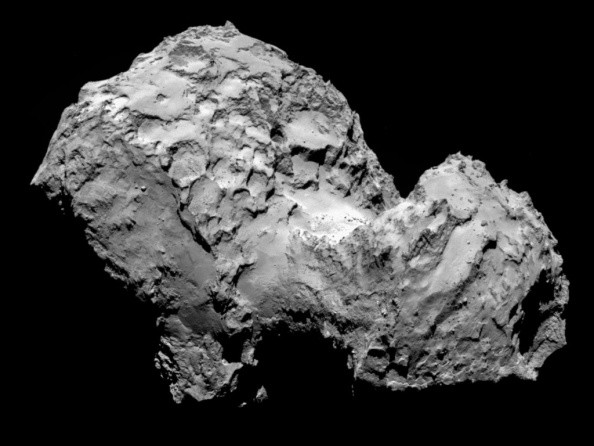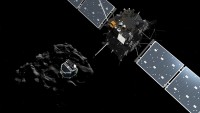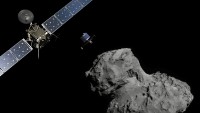Did Rosetta Mission Find Aliens In Space? Scientists Discover ‘Distinct And Unexpected Features’ On Comet Surface
| KJ Belonio | | Jul 06, 2015 07:19 AM EDT |
(Photo : Getty Images/ESA) Comet 67P/Churyumov-Gerasimenko, which is described as a “rubber duck, is consist of black hydrocarbon crust dubbed as icy “seas.” While its flat-bottomed crater lakes are refrozen water covered in organic debris.
The European Space Agency's Rosetta mission has discovered a direct evidence that might suggest aliens do exist. According to the scientists, the distinct and unexpected features found on the surface of Comet 67P/Churyumov-Gerasimenko is an indication that the comet could be home to life.
Like Us on Facebook
A team of astronomers, who have been studying the findings of ESA's Rosetta spacecraft and its Philae lander, believe that the comet is more hospitable for life than Earth's own Polar Regions. The presence of alien microbial life beneath the comet's icy surface can be best explained by its organic-rich black crust. They added that the spacecraft have also picked up strange "clusters" of organic materials that are similar to viral particles, Daily Mail has learned.
Lead astronomers, Director of the Buckingham Centre for Astrobiology professor Chandra Wickramasinghe and his colleague Dr. Max Wallis from the University of Cardiff, conjectured that Comet 67P and other similar comets could support living microbes like the "extremophiles," which inhabit the most uninhabitable areas of the Earth. The two also added that comets like 67P could be responsible for bringing life to the Earth and potentially other planets, RT.com reported.
Comet 67P/Churyumov-Gerasimenko, which is described as a "rubber duck, is consist of black hydrocarbon crust dubbed as icy "seas." While its flat-bottomed crater lakes are refrozen water covered in organic debris. The Independent added its large furrows correspond to the movement on the body that causes fractures in the ice underneath.
Moreover, Wickramasinghe believed the data received from Comet 67 through ESA's Rosetta spacecraft and its Philae lander could be proof that microorganisms are involved in the development of the icy structures, the mass of aromatic hydrocarbons and the very dark surface of the comet. While Wallis added the findings indicate the comet is not a deep-frozen inactive body, instead it supports geological processes that could be more livable for alien microbial life than Earth's Arctic and Antarctic regions.
Unfortunately, neither Rosetta nor its lander, which has been a momentous breakthrough in space expedition history, are capable in searching for direct evidence of life in Comet 67P. As a matter of fact, an initial proposal to equip the mission with the right technology to detect life was allegedly laughed out of court.
Meanwhile, the astronomers will confer their findings at the Royal Astronomical Society's National Astronomy Meeting in Llandudno, Wales.
Tags Rosetta mission, rosetta spacecraft, philae lander, rosetta philae comet, aliens, comet 67P, Comet 67P/Churyumov-Gerasimenko, outer space, comets, Philae Probe
©2015 Chinatopix All rights reserved. Do not reproduce without permission
EDITOR'S PICKS
-

Did the Trump administration just announce plans for a trade war with ‘hostile’ China and Russia?
-

US Senate passes Taiwan travel bill slammed by China
-

As Yan Sihong’s family grieves, here are other Chinese students who went missing abroad. Some have never been found
-

Beijing blasts Western critics who ‘smear China’ with the term sharp power
-

China Envoy Seeks to Defuse Tensions With U.S. as a Trade War Brews
-

Singapore's Deputy PM Provides Bitcoin Vote of Confidence Amid China's Blanket Bans
-

China warns investors over risks in overseas virtual currency trading
-

Chinese government most trustworthy: survey
-

Kashima Antlers On Course For Back-To-Back Titles
MOST POPULAR
LATEST NEWS
Zhou Yongkang: China's Former Security Chief Sentenced to Life in Prison

China's former Chief of the Ministry of Public Security, Zhou Yongkang, has been given a life sentence after he was found guilty of abusing his office, bribery and deliberately ... Full Article
TRENDING STORY

China Pork Prices Expected to Stabilize As The Supplies Recover

Elephone P9000 Smartphone is now on Sale on Amazon India

There's a Big Chance Cliffhangers Won't Still Be Resolved When Grey's Anatomy Season 13 Returns

Supreme Court Ruled on Samsung vs Apple Dispute for Patent Infringement

Microsoft Surface Pro 5 Rumors and Release Date: What is the Latest?













